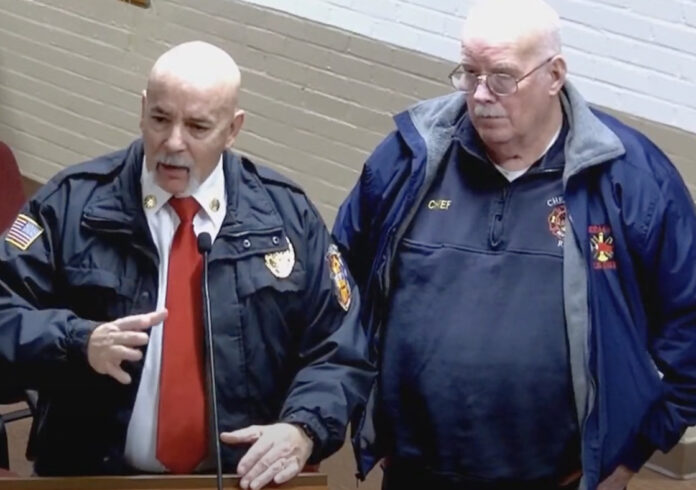
GLOCESTER – Trained emergency medical personnel are hard to get and hard to keep, especially for volunteer fire departments, such as Glocester’s.
At the recent Town Council meeting, the board members agreed that it is time to sit down with the local fire chiefs and boards from Harmony, Chepachet and West Glocester, and to see what can be done to help alleviate the problem.
“You talk to anyone on the fire department, and they’ll tell you it is tough to get volunteers,” said Councilor Walter Steere.
He added that the district has been advertising to get emergency medical technicians, in particular.

“Ultimately, what we need to ensure is that the town’s covered, so if someone needs help, it’s coming,” added Steere.
Moving forward, he said, solutions need to be found for the short term, as well as the long term. He said sitting down with the fire departments and brainstorming might provide some of those solutions.
“I’m not talking about fire(s),” said Steere. “I’m just talking about emergency (medical) services. What’s it going to look like in the next five years, 10 years, 15 years?”
Steere said that the emergency medical teams do a great job, but going forward is going to be a challenge. He also made it clear that it isn’t a case of the town taking over the fire departments, but rather sitting down and seeing what can be done, and how the council can help.
“I don’t want the town taking over anything,” Steere explained. “I want to have a discussion to see what we can do to make sure that when someone needs help, they get help now and in the future.”
Steere suggested that the town write a letter to the various fire department boards in order to make that happen.
“We’re probably overdue in having this conversation,” agreed Council Vice President Stephen Arnold. “This might make sense for everybody to see how the town can help and make sure everybody in the town is covered.”
Steere said the number of calls for services is going up and will continue to go up. Not all of those calls, apparently, were actual emergencies.
Harmony Fire Chief Richard Waterman explained that many of the calls they receive were not actually emergency medical, but for minor problems or services.
“Nowadays we get calls from everything from an emergency because someone is having a heart attack to the person who stubbed their toe, or they have a nosebleed they can’t stop, which could be because of high blood pressure, but mostly it’s not,” said Waterman. “It’s just one of those things where everybody calls for the fire department, especially the rescue, because they don’t know what else to do. They haven’t been taught that emergency services are used when it’s an emergency.”
All of the town’s fire departments are volunteer, which pay per diem for rescue personnel. Last year, the Harmony District paid $369,000 for 24/7 per diem shifts. Chepachet Fire Chief Dennis Huestis said his department responded to 1,083 calls, 800 of which were rescue related. Waterman said 80 percent of calls are for emergency medical services and only 20 percent for fire services.
“That’s because everybody calls for the rescue,” he added.
Waterman said one of the big pluses is the Interstate Mutual Aid Program, which calls for local fire and rescue departments to share services as needed. That means if one district is fighting a fire and another fire breaks out in the same town, fire departments from surrounding towns come to their aid. The same is true for medical services.
Smithfield, said Waterman, solved the problem of being shorthanded by adding full-time fire and rescue personnel during the daytime in 1966. They added 15 people to three stations.
“We have that same problem now,” Waterman explained.
A basic EMT certificate requires 350 hours of classroom education, said Huestis, noting it costs about $1,500.
Waterman added that the districts pay them back for that training over the course of a year with a stipend. The problem, he said, is that when rescue personnel gain experience and knowledge, and add more licenses to their resume, they often move on to full-time positions in other towns where they can earn much more. Some also go on to become nurses or other medical-related professions.

“If you’re a paramedic, you’re not going to stay on a department that is doing per diem because you can get paid more to go somewhere else,” said Waterman. “Per diem is not the answer. It’s a band aid on an amputation. We’ve been doing this now for a long time in this town, and it’s been working up until covid.”
After covid, he added, many did not return. Waterman said the three departments have been meeting to try to figure out a solution. Other towns, he added, do pay more for per diem workers. But, money, he said, is not the answer.
“We need to figure out what it is we need to bring them in and keep them here,” he said.
“So how do we break the cycle?” asked Arnold.
“That’s a good question,” responded Waterman. “That’s why we’re here. I would love to see the Town Council help us. I’m not sure if you have any ideas we haven’t already thought of, but why not sit down and have a discussion. At the end of the day, it’s all about making sure we have the protection that the citizens need and the citizens should get.”
The council agreed to send a letter to the boards of the three departments requesting a meeting to try to come up with a solution.






